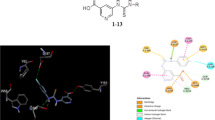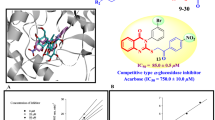Abstract
As a type of β-N-acetyl-D-hexosaminidase enzyme purified from the Ostriniafurnacalis (Asian corn borer), OfHex1 has been previously reported to participate in chitin degradation, indicating that it may be an ideal target for designing new environmentally friendly pesticides. Besides, a natural product, TMG-chitotriomycin, has been found to be an effective inhibitor of OfHex1, and some studies have shown that the interactions between TMG unit and residues in − 1 subsite of OfHex1 are very conservative and important, inspiring us to design new inhibitors of β-N-acetyl-D-hexosaminidase with a new strategy. In the present study, the virtual screening of TMG unit as the core fragment was conducted using the combined computational methods, such as docking, molecular dynamics, pharmacophore model, and pesticide-likeness rule. Nine compounds with the binding free energy lower than TMG-β-(GlcNAc)2 were obtained. According to the decomposition energy and the interactions analysis, compounds 2, 3, 6 and 8, forming the hydrogen bonds with Val327 and Trp490, were considered as the possible lead structures for the further study. Our findings indicated that fragment-based lead discovery strategy might provide valuable insights into designing novel potential OfHex1 inhibitors.






Similar content being viewed by others
References
Ort, D. R., & Long, S. P. (2014). Limits on ields in the corn belt. Science, 344, 483–484.
Li, J., Coates, B. S., Kim, K. S., Bourguet, D., Ponsard, S., He, K. L., & Wang, Z. Y. (2014). The genetic structure of Asian corn borer, Ostrinia furnacalis, populations in China: haplotype variance in Northern populations and potential impact on management of resistance to transgenic maize. The Journal of Heredity, 105(5), 642–655.
Wang, Z., He, K., & Yan, S. (2005). Large-scale augmentative biological control of Asian corn borer using Trichogramma in China: a success story. Second International Symposium on Biological Control of Arthropods, Davos, Switzerland, 12-16 September, 2005 (pp. 487–494).
Intra, J., Pavesi, G., & Horner, D. S. (2008). Phylogenetic analyses suggest multiple changes of substrate specificity within the Glycosyl hydrolase 20 family. BMC Evolutionary Biology, 8, 17.
Liu, T. A., Zhang, H. T., Liu, F. Y., Wu, Q. Y., Shen, X., & Yang, Q. (2011). Structural determinants of an insect beta-N-Acetyl-D-hexosaminidase specialized as a chitinolytic enzyme. The Journal of Biological Chemistry, 286(6), 4049–4058.
Knapp, S., Vocadlo, D., Gao, Z. N., Kirk, B., Lou, J. P., & Withers, S. G. (1996). NAG-thiazoline, an N-acetyl-beta-hexosaminidase inhibitor that implicates acetamido participation. Journal of the American Chemical Society, 118(28), 6804–6805.
Horsch, M., Hoesch, L., Vasella, A., & Rast, D. M. (1991). N-acetylglucosaminono-1,5-lactone oxime and the corresponding (phenylcarbamoyl) oxime - novle and potent inhibitors of beta-N-acetylglucosaminidase. European Journal of Biochemistry, 197(3), 815–818.
Liu, T., Guo, P., Zhou, Y., Wang, J., Chen, L., Yang, H. B., Qian, X. H., & Yang, Q. (2014). A crystal structure-guided rational design switching non-carbohydrate inhibitors' specificity between two beta-GlcNAcase homologs. Scientific Reports, 4, 6.
Usuki, H., Nitoda, T., Ichikawa, M., Yamaji, N., Iwashita, T., Komura, H., & Kanzaki, H. (2008). TMG-chitotriomycin, an enzyme inhibitor specific for insect and fungal beta-N-acetylglucosaminidases, produced by actinomycete Streptomyces anulatus NBRC 13369. Journal of the American Chemical Society, 130(12), 4146–4152.
Yang, Y., Liu, T. A., Yang, Y. L., Wu, Q. Y., Yang, Q., & Yu, B. A. (2011). Synthesis, evaluation, and mechanism of N,N,N-Trimethyl-D-glucosamine-(1 - > 4)-chitooligosaccharides as Selective Inhibitors of Glycosyl Hydrolase Family 20 beta-N-Acetyl-D-hexosaminidases. ChemBioChem, 12(3), 457–467.
Murray, C. W., & Rees, D. C. (2009). The rise of fragment-based drug discovery. Nature Chemistry, 1(3), 187–192.
Hao, G. F., Wang, F., Li, H., Zhu, X. L., Yang, W. C., Huang, L. S., Wu, J. W., Berry, E. A., & Yang, G. F. (2012). Computational Discovery of Picomolar Q(o) Site Inhibitors of Cytochrome bc(1) Complex. Journal of the American Chemical Society, 134(27), 11168–11176.
Hao, G. F., Dong, Q. J., & Yang, G. F. (2011). A comparative study on the constitutive properties of marketed pesticides. Molecular Informatics, 30(6-7), 614–622.
Liu, C. L. (2002). Shi Jie Nong Yao Da Quan : Chu Cao Ji Juan (in Chinese). Beijing: Chemical Industry Press.
Kolb, P., & Caflisch, A. (2006). Automatic and efficient decomposition of two-dimensional structures of small molecules for fragment-based high-throughput docking. Journal of Medicinal Chemistry, 49(25), 7384–7392.
Jhoti, H., Williams, G., Rees, D. C., & Murray, C. W. (2013). The ‘rule of three’ for fragment-based drug discovery: where are we now? Nature Reviews. Drug Discovery, 12(8), 644–64+.
Durrant, J. D., Amaro, R. E., & McCammon, J. A. (2009). AutoGrow: A Novel algorithm for protein inhibitor design. Chemical Biology & Drug Design, 73(2), 168–178.
CASE D A, E. A. (2012) AMBER 12. University of California, San Francisco.
Hu, S., Zhao, X., & Zhang, L. (2019). Computational study for the unbinding routes of β-N-Acetyl-D-hexosaminidase inhibitor: insight from steered molecular dynamics simulations. International Journal of Molecular Sciences, 20, 1–14.
Hu, S., Dong, Y. W., Zhao, X., & Zhang, L. (2019). Insights into the structure-affinity relationships and solvation effects between OfHex1 and inhibitors using molecular dynamics simulations. Journal of Molecular Graphics & Modelling, 90, 1–8.
MOE2014. Chemical Computing Group Inc 1010 Sherbooke St. West, Suite #910, Montreal, QC, Canada, H3A 2R7.
Hopkins, A. L., Groom, C. R., & Alex, A. (2004). Ligand efficiency: a useful metric for lead selection. Drug Discovery Today, 9, 430–431.
Case, D. A., Darden, T. A., Cheatham, T. E. III, Simmerling, C. L., Wang, J., Duke, R. E., ... Roberts, B. (2012). AMBER 12. San Francisco: University of California.
Wang, J. M., Wolf, R. M., Caldwell, J. W., Kollman, P. A., & Case, D. A. (2004). Development and testing of a general amber force field. Journal of Computational Chemistry, 25(9), 1157–1174.
Lindorff-Larsen, K., Piana, S., Palmo, K., Maragakis, P., Klepeis, J. L., Dror, R. O., & Shaw, D. E. (2010). Improved side-chain torsion potentials for the Amber ff99SB protein force field. Proteins, 78, 1950–1958.
Jakalian, A., Jack, D. B., & Bayly, C. I. (2002). Fast, efficient generation of high-quality atomic charges. AM1-BCC model: II. Parameterization and validation. Journal of Computational Chemistry, 23(16), 1623–1641.
Case, D. A., Cheatham, T. E., Darden, T., Gohlke, H., Luo, R., Merz, K. M., Onufriev, A., Simmerling, C., Wang, B., & Woods, R. J. (2005). The Amber biomolecular simulation programs. Journal of Computational Chemistry, 26, 3314–3321.
Miller, B. R., McGee, T. D., Swails, J. M., Homeyer, N., Gohlke, H., & Roitberg, A. E. (2012). MMPBSA.py: An Efficient Program for End-State Free Energy Calculations. Journal of Chemical Theory and Computation, 8(9), 3314–3321.
Pan, Y. M., Gao, D. Q., & Zhan, C. G. (2008). Modeling the catalysis of anti-cocaine catalytic antibody: competing reaction pathways and free energy barriers. Journal of the American Chemical Society, 130(15), 5140–5149.
Verma, S., & Prabhakar, Y. S. (2015). Target based drug design - a reality in virtual sphere. Current Medicinal Chemistry, 22(13), 1603–1630.
Abad-Zapatero, C., & Metz, J. T. (2005). Ligand efficiency indices as guideposts for drug discovery. Drug Discovery Today, 10(7), 464–469.
Acknowledgments
We thank Prof. Guangfu Yang and Dr. Gefei Hao who provide PFVS program.
Funding
This work was supported by the National Natural Science Foundation of China [No. 21272265] and the National Key R&D Program of China [No. 2017YFD0200504].
Author information
Authors and Affiliations
Corresponding author
Ethics declarations
The authors declare that they have no conflict of interest.
Additional information
Publisher’s Note
Springer Nature remains neutral with regard to jurisdictional claims in published maps and institutional affiliations.
Electronic supplementary material
ESM 1
The following are available online at www.mdpi.com/link, Table S1: The ΔΔGcal values of compounds 10-20,Fig. S1: The structures of compounds 10-20, Fig. S2: The decomposition energies of the important residues on OfHex1 binding compounds 1 and 3-9. Fig. S3-S10: The interactions of compounds 1, 3, 4, 5, 6, 7, 8, 9 and OfHex1 in + 1 subsite, respectively. (DOCX 1367 kb)
Rights and permissions
About this article
Cite this article
Hu, S., Zhao, X. & Zhang, L. Computational Screening of Potential Inhibitors of β-N-Acetyl-D-Hesosaminidases Using Combined Core-Fragment Growth and Pharmacophore Restraints. Appl Biochem Biotechnol 189, 1262–1273 (2019). https://doi.org/10.1007/s12010-019-03064-4
Received:
Accepted:
Published:
Issue Date:
DOI: https://doi.org/10.1007/s12010-019-03064-4




